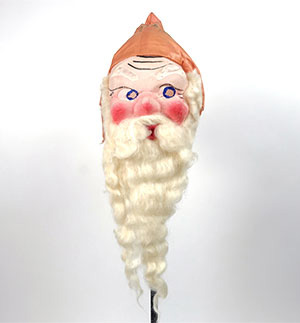New artifacts at the Bullock Museum tell unique history of Wendish settlement, culture in 1800s Texas
Rare artifacts, including 'Rumpliche' mask, on view through the holidays
DECEMBER 9, 2015 (AUSTIN, TX) — Rare artifacts highlighting Wendish culture and holiday traditions are on view now at the Bullock Texas State History Museum, including a 1732 book of Martin Luther's sermons and a mask of a Santa-like character named 'Rumpliche.'
These rare pieces, on loan from the Texas Wendish Heritage Museum in Serbin, Texas, offer a view of the cultural traditions of the Wends, a Slavic group from eastern Germany who risked everything to preserve their religious beliefs and cultural identity when they began immigrating to Texas in 1849.
"We are very excited to borrow these artifacts and share the culture of the Wends from Central Texas with visitors to the museum," Dr. Victoria Ramirez, Executive Director of the Bullock Museum, said. "The story of the Wendish migration to Texas reflects the rich diversity that has shaped the culture of the state."
Wishing to maintain their autonomy as Lutherans, more than 500 Wends crossed the Atlantic in 1854 to establish the community of Serbin, located about an hour east of Austin. Their voyage was plagued by both cholera and yellow fever. Wends who traveled under the leadership of Pastor Johann Kilian are listed in the ship's register, a document on view at the Bullock Museum.
Visitors are invited to see artifacts showcasing traditional Wendish life, such as a black wedding dress from 1879, a pine trunk from the 1840s used to transport family possessions to Texas, and a rare book of Martin Luther's sermons brought to Texas by Pastor Kilian.
Also featured is a mask from the 1920s-1930s of Rumpliche, a character similar to Santa Claus that was part of the Wendish holiday tradition. In a traditional Wendish home, the masked Rumpliche would visit each house with a stick or switch and a sack to ask if the children had been naughty or nice that year. If a child was naughty, he or she was put in the sack where they would say a prayer to be let out. Good children might receive toys and treats.
Wearing the Rumpliche mask and costume was a rite of passage for young Wendish men, and often they would plot with a younger boy to take him away in the sack, thus scaring the other children into being good. Although the tales and memories of Rumpliche live on in Wendish culture, the character was gradually replaced by the more jovial Santa Claus during the 1950s. The mask currently on view at the Bullock Museum offers a glimpse of this regional holiday tradition.
The Wendish artifacts are on loan through April 2016 courtesy of the Texas Wendish Heritage Museum and will be on view on the second floor of the Bullock Museum's Cultural Crossroads section, which contains artifacts displaying the experience of the people who settled in Texas. The Bullock Museum is located at 1800 N. Congress Ave. in downtown Austin. Visit TheStoryofTexas.com or call (512) 936-8746 for hours and admission prices.
Downloads
The Bullock Texas State History Museum, a division of the State Preservation Board and an accredited institution of the American Alliance of Museums, creates experiences that educate, engage, and encourage a deeper understanding of Texas. With dynamic, award-winning exhibitions that illuminate Texas history, people, and culture, educational programming for all ages, and an IMAX® theater with a screen the size of Texas, the Museum collaborates with more than 700 museums, libraries, archives, organizations, and individuals across the world to bring the Story of Texas to life. For more information, visit www.TheStoryofTexas.com
About the Texas Wendish Heritage Museum The Texas Wendish Heritage Museum, located in Serbin, Texas, preserves the history of the Texas Wends, Slavic immigrants from Germany, through a library, archives, exhibits, and gift shop. Exhibits include relics from the Old Country and Texas, including traditional wedding dresses and beautiful Wendish Easter eggs. Outdoor exhibits include two log buildings, including one from 1856, and early farming equipment. Details at TexasWendish.org.
Media Contact
| General Inquiries | |
|---|---|
| 512-463-5424 | |
